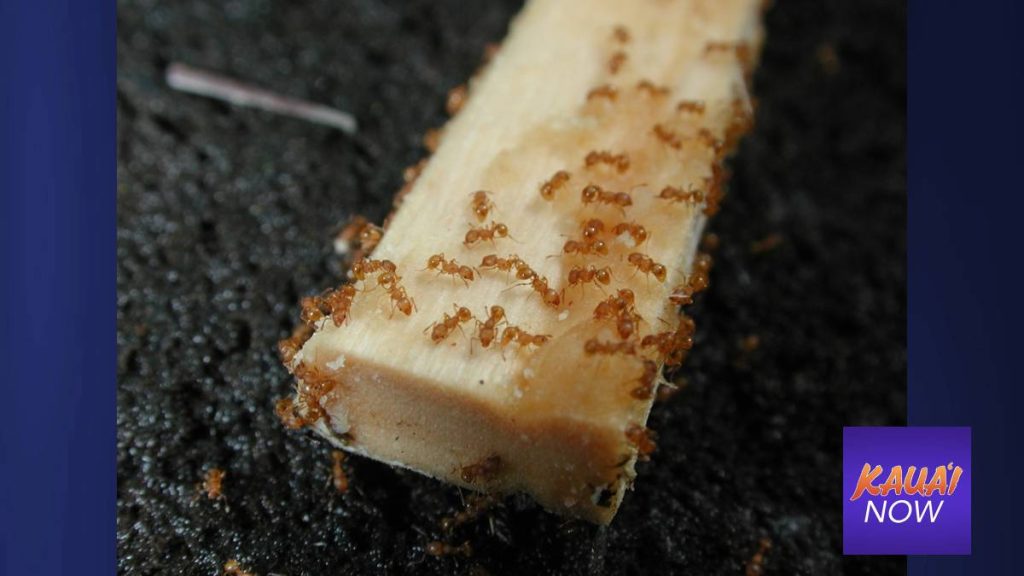Little fire ants invading Kaua‘i; Big Island already knows their destruction
Little fire ants have been invading Kauaʻi, as they already have done on the Big Island.
“These little bugs pack a mean punch,” personnel said in the December newsletter of the Kaua’i Invasive Species Committee.
Their stings cause intense burning and itching sensations that can last for weeks. They cause harm to plant and animal life by fostering growth of other pests like aphids and mealybugs. And, they can cause blindness in pets or livestock by stinging soft tissues around the eyes.
In late 2022, the Kauaʻi-based committee reported that little fire ants (Wasmannia auropunctata) have infested another 55 acres, this time in Kōloa and ʻŌmaʻo. The discovery is the largest infestation of these harmful ants ever recorded on Kaua‘i, and the first documented on the island’s South Shore.
It comes on the heels of an infestation of at least 16 acres found about 12 miles away in Wailuā earlier in 2022, according to the committee.

“Kauaʻi is now at a tipping point when it comes to preventing widespread establishment of [little fire ants] across the island,” the committee said.
The Kaua’i Invasive Species Committee is a partnership of government, private and nonprofit organizations tasked with the prevention, control or elimination of invasive plant and animal species on The Garden Isle. It’s one of several organizations – including the Hawai‘i Department of Agriculture and the University of Hawai‘i’s Hawai‘i Ant Lab – tackling little fire ants on Kaua‘i.
To deal with the problem is not cheap. Treatment of the South Side infestation may cost between $1 and $2 million, depending on the treatment plan and a final determination of the infestation area’s size, committee project manager Tiffani Keanini said.
But it’s more economical to deal with the fire ants now before they invade other areas, which they can do rapidly.

The insects are small, only as long as a penny is thick. One ant nest capable of starting a new colony can fit inside a macadamia nut shell. But the small creatures can wreak havoc on a landscape scale: farmers in Mahina, Tahiti, have abandoned their lands due to the ants, according to the committee.
A 2014 research paper published by an inter-governmental conservation organization found more than 1,191 little fire ant-infested acres in Mahina, 10 years after the species’ official detection on the island. In the Galapagos, the ants attack the eyes of adult tortoises and eat tortoise hatchlings.
Little fire ants already are well-established on Hawai‘i Island, where they’ve caused residents plenty of grief.
“It’s already hard work to open this ‘āina, ‘not considering having it raining fire. Every time we cut from the bottom, showers of fire ants come raining down,” Waipiʻo Valley farmer Iʻini Kahakalau told the committee.
Little fire ants were first discovered on Kaua‘i in 1999, in Kalihiwai on the island’s North Shore. They had arrived as hitchhikers in an untreated box of palms sourced from Hawai‘i Island.
A second Kaua‘i infestation was reported in another North Shore area, Kīlauea, in 2019. Little fire ants appeared to be eradicated from both the Kalihiwai and Kīlauea sites in late 2021, when state pest-management experts publicly discussed their response to a 13-acre infestation discovered in Moloaʻa in northeast Kaua‘i that summer.
Roshan Manandhar, an assistant extension agent, entomologist and invasive pest expert for the University of Hawai‘i on Kaua‘i, is not involved in the committee’s current ant control efforts. But he is treasured by local food growers as a valuable source of knowledge, and recently described the ants’ unique biology from his bug-filled office in Līhuʻe.
“Their habitat is a little bit more arboreal than other ants,” Manandhar said. “Other ants make nests in the ground … but little fire ants live in plant parts [like tree limbs].”
There are 60 species of ants recorded in the State of Hawai‘i, according to Manandhar. None are native to the island chain.
Despite the threat they pose to farmers and livestock, little fire ants are farmers themselves. They manage populations of homopteran insects like aphids, scales, mealybugs and other plant pests, for the sugary excretions the bugs produce.

“They are an eusocial insect. Like all ants, they are in the myrmicine family … they live together symbiotically, particularly with some other living things,” Manandhar explained.
The “sugar drops” prized by little fire ants are known as honeydew.
Black mold generated by the homopteran insects nurtured by little fire ants insects can damage farmersʻ crops. The black mold stunts growth and causes fruit spoilage.
Little fire ants, which are native to Central and South America, are also polygynous – meaning their colonies may have more than one queen. This fact, combined with their status as champion hitchhikers, contributes to their rapid spread across the world.
“Once they’re crowded and their population size increases, they produce another queen,” Manandhar said. “The colony needs a little more space, they have lots of little fire ants, so the colony goes out and forms another colony … and they do not compete with each other within the colonies. That’s how they are invasive. They spread rapidly.”
The Kaua’i Invasive Species Committee has not publicly identified the precise locations of the latest infestations in Wailuā, Kōloa and ʻŌmaʻo due to its standard confidentiality agreements with landowners.
However, in December, the committee reported field crews trained in rappelling would comb steep terrain near the Wailuā River sometime this month, to identify the 16-acre infestation’s south and west boundaries. This step is needed to come up with a plan for eradication.
For more information about little fire ant identification or to report an infestation, visit Stoptheant.org and KISC’s dedicated little fire ants webpage













